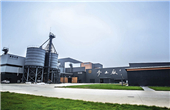Transfrom Construction Waste into Resources
China Today by Dang Xiaofei, October 13, 2016 Adjust font size:
The almost two-meter-high sculpture Liu Xiaofan admired at an exhibition, and which he assumed was bronze, turned out to have been made from recycled building waste. Liu immediately thought of the pile of demolition debris next to his home. He had witnessed new construction waste steadily piling up next to his apartment building and the community public lawn. Dust floated high and free as the wind blew and deposited it on his balcony. This epitomizes the “metabolism” of Chinese cities.
Growing Annoyance
In the past few years construction waste has amounted to 1.55 to 2.4 billion tons per year, accounting for 40 percent of the total waste in urban areas. It mainly consists of residue soil, abandoned spoil, and discarded slag produced during the construction of urban infrastructure, laying or removal of pipe networks, and house renovations.
When Wang Qiang first came to Beijing over a dozen years ago he worked as a truck driver transporting residue soil. Now he has his own transport company in this business, and has witnessed the explosive growth of urban construction waste. “You can’t imagine that this waste will ever be cleared up. As long as there is a building project, there will be construction waste,” he said. “Now every pit on Beijing’s outskirts is full.” Wang recalled how people used to pour waste into any pit they could find due to the lack of operation standardizations. In 2015 alone the 3,700 plus construction sites in Beijing created about 40 million tons of waste.
Professor Wang Yimin of the School of Architecture, Tsinghua University, believes that primitive and tough approaches to propelling today’s unprecedented urbanization and concomitant large-scale demolition and renovation have come to the fore in the last few decades. These ways and ideas of dealing with waste are outdated, and have created the garbage tableaux that besiege the country’s cityscapes.
“The old ways of dealing with construction waste, such as piling, burning, and landfill, have resulted in such hazards as land trespassing, and water, air, and soil pollution,” Wang said, adding that safety is another major concern.
“Construction waste is in fact a treasure house,” secretary general of China Industry Innovation Strategic Alliance of Construction Waste Resourcezation Guo Haibin said. Most waste produced during construction can be utilized as renewable resources, he added.

